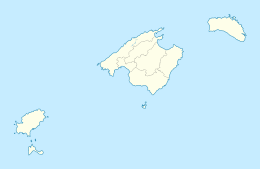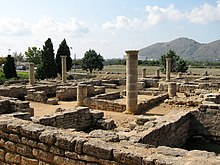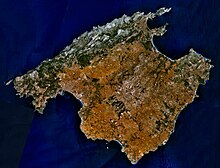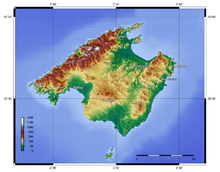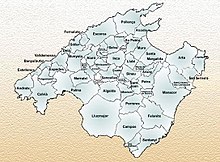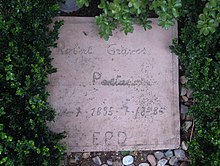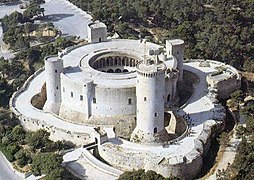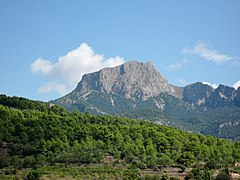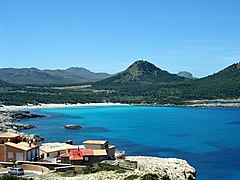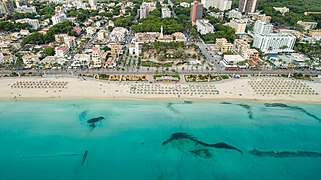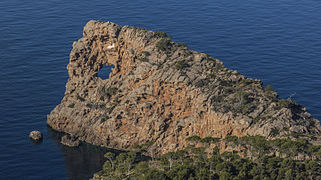Не все знают, как писать название одного из Балеарских островов – «Мальорка» или «Майорка»? Нормативное написание с «ль» или «й»? Воспользуемся специальными справочниками, чтобы ответить на этот вопрос.
Читайте в статье
- Как пишется правильно: «Мальорка» или «Майорка»?
- Какое правило применяется?
- Примеры предложений
- Как неправильно писать
Как пишется правильно: «Мальорка» или «Майорка»?
Верным считается следующее написание – «Мальорка» и «Майорка».
Какое правило применяется?
Рассматриваемое слово – это топоним, т.е. имя собственное, обозначающее название какого-либо географического объекта. В данном случае мы говорим об острове, который расположен в Средиземном море (принадлежит Испании). В испанском языке название острова пишется так – «Mallorca». Если писать имя собственное с согласной «л» в середине, то такой вариант будет соотноситься с оригинальным написанием. В свою очередь, написание слова с «й» будет отвечать испанскому произношению («ll» читается как «й»). Исходя их этого, «Мальорка» и «Майорка» – это нормативные варианты.
Как видим, выбрать правильное написание топонимов непросто, поэтому лучше обращаться за помощью к словарям.
Примеры предложений
- Мы целый месяц отдыхали на острове Майорка.
- Остров Мальорка из окна самолёта казался крошечным.
Как неправильно писать
Некорректно: «Мольорка», «Мойорка», «Малльорка».
Содержание
- Как правильно пишется
- Какое правило применяется
- Примеры предложений
- Как неправильно писать
Сомневаетесь, как писать «Мальорка» или «Майорка»? Нам необходимо воспользоваться специальными словарями, чтобы сделать правильный выбор и запомнить норму правописания. Давайте вместе к ним обратимся.
Как правильно пишется
Орфографические словари фиксируют оба варианта существительного – Мальорка и Майорка.
Какое правило применяется
Данное слово является топонимом, т.е. обозначает название географического объекта (острова). Топонимы плохо подчиняются правил русского языка, их написание нужно проверять по словарям имен собственных. Если мы его откроем, то убедимся, что оба варианта верны. В испанском языке это слово имеет следующий вид – Mallorca. Вариант с согласной «л» соответствует оригинальному написанию, а варрант с буквой «й» соответствуют испанскому произношению, ведь сочетание «ll» в этом языке произносится как «й». Таким образом, вы можете употреблять оба слова.
Примеры предложений
- Остров Мальорка расположен в Средиземном море.
- Майорка – место, о котором у меня останутся наилучшие воспоминания.
Проверь себя: «Сжог» или «сжёг» как пишется?
Как неправильно писать
Неверного варианта тут не представлено.
( 1 оценка, среднее 5 из 5 )
«Мальорка» или «Майорка» как пишется?
Сомневаетесь, как писать «Мальорка» или «Майорка»? Нам необходимо воспользоваться специальными словарями, чтобы сделать правильный выбор и запомнить норму правописания. Давайте вместе к ним обратимся.
Как правильно пишется
Орфографические словари фиксируют оба варианта существительного – Мальорка и Майорка.
Какое правило применяется
Данное слово является топонимом, т.е. обозначает название географического объекта (острова). Топонимы плохо подчиняются правил русского языка, их написание нужно проверять по словарям имен собственных. Если мы его откроем, то убедимся, что оба варианта верны. В испанском языке это слово имеет следующий вид – Mallorca. Вариант с согласной «л» соответствует оригинальному написанию, а варрант с буквой «й» соответствуют испанскому произношению, ведь сочетание «ll» в этом языке произносится как «й». Таким образом, вы можете употреблять оба слова.
Всё о Майорке
Путеводитель по Майорке на русском
….Если страдаешь неврастенией или думаешь,что ей страдаешь; если чувствуешь головокружение от шума города ; если с тоской думаешь о том, что снова надо куда-то торопиться и прибыть первым туда, где нечего делать, следуй за мной на остров, где всегда спокойно, где люди никуда не спешат, где женщины никогда не стареют, где не тратят лишних слов, где солнце долго не заходит и даже луна двигается лениво. Этот остров — Майорка. Сантьяго Русиньол
Все что нужно знать тем кто впервые едет на остров
5 часов на самолёте от Москвы, 4 из Киева или 13 из Новосибирска и Вы — в Раю.
Белоснежные пляжи, фантастические лазурные заливы, кристальные водохранилища с чистейшей водой (на острове нет ни одной реки!), горы, склоны которых покрыты сосновыми лесами. Дубовые рощи, плантации столетних олив, бесконечные виноградники — Вся Майорка может уложиться в одно точное определение — ОСТРОВ МЕЧТЫ.
Один из самых популярных курортов Средиземноморья расположен практически посреди западного бассейна Средиземного моря —15 минут чистого полетного времени или 180 км до Иберийского побережья и 272 до побережья Алжира.
Будучи частью Балеарского архипелага, остров, в итоге многочисленных исторических перипетий, стала частью Королевства Испании.
Но не официально считается «немецкой вотчиной», потому как среди миллионов туристов более 40% отдыхающих и свыше 30% резидентов — немцы. Которые, кстати, знают толк в «качестве жизни» и умеют делать хороший выбор. Кстати, многие немцы уверены, что фактически Мальорка это «17й Бундесланд» (федеральная земля) Германии.
Остров Майорка, Испания – полезная информация для туристов
● Мальорка или Майорка — самый большой остров Испании, его площадь — 3640,16 км²
● Протяженность берега, пожалуй, тоже одна из самых внушительных — 554,3 км.
● Самая высокая гора Пуч-Майор (Puig Mayor) 1442 метра, закрытая военная зона, изначально была выше. Но когда американцы строили станцию слежения НАТО верхушку пика пришлось спилить на 3 метра, чтобы освободить место для площадки радара.
● На острове проживают 923.608 жителей. Это наиболее густонаселенный из Балеарских остров и второй по численности обитателей остров в Испании, после Тенерифе на архипелаге Канарских островов.
● Остров имеет свой гимн Балангера «La Balanguera» и флаг
● Пальма-де-Майорка – самый большой город не только на острове, но и на всем архипелаге. Помимо того, что Пальма является административным центром острова, она же – столица автономного сообщества островов Балеарского архипелага.
● В столице средиземноморской жемчужины Пальма-де-Майорка живет 409.661 человек (2019 год).
● Островной совет Мальорки управляет в административном плане шестью камарками (районами): Пальма, Пла де Мальорка, Сьерра де Трамонтана, Райгер, Миджёрн, Левант.
● Второй по величине город острова Манакор, столица камарки Левант, в нем проживает 42.631
«Мальорка» или «Майорка» – как правильно?
Не все знают, как писать название одного из Балеарских островов – «Мальорка» или «Майорка»? Нормативное написание с «ль» или «й»? Воспользуемся специальными справочниками, чтобы ответить на этот вопрос.
Как пишется правильно: «Мальорка» или «Майорка»?
Верным считается следующее написание – «Мальорка» и «Майорка».
Какое правило применяется?
Рассматриваемое слово – это топоним, т.е. имя собственное, обозначающее название какого-либо географического объекта. В данном случае мы говорим об острове, который расположен в Средиземном море (принадлежит Испании). В испанском языке название острова пишется так – «Mallorca». Если писать имя собственное с согласной «л» в середине, то такой вариант будет соотноситься с оригинальным написанием. В свою очередь, написание слова с «й» будет отвечать испанскому произношению («ll» читается как «й»). Исходя их этого, «Мальорка» и «Майорка» – это нормативные варианты.
Как видим, выбрать правильное написание топонимов непросто, поэтому лучше обращаться за помощью к словарям.
источники:
http://gidmallorca.com/vsya-majorka
http://znanieinfo.ru/orfografiya/malorka-ili-mayorka-kak-pravilno.html
«Мальорка» или «Майорка» – как правильно?
Не все знают, как писать название одного из Балеарских островов – «Мальорка» или «Майорка»? Нормативное написание с «ль» или «й»? Воспользуемся специальными справочниками, чтобы ответить на этот вопрос.
Содержание
- Как пишется правильно: «Мальорка» или «Майорка»?
- Какое правило применяется?
- Примеры предложений
- Как неправильно писать
Как пишется правильно: «Мальорка» или «Майорка»?
Верным считается следующее написание – «Мальорка» и «Майорка».
Какое правило применяется?
Рассматриваемое слово – это топоним, т.е. имя собственное, обозначающее название какого-либо географического объекта. В данном случае мы говорим об острове, который расположен в Средиземном море (принадлежит Испании). В испанском языке название острова пишется так – «Mallorca». Если писать имя собственное с согласной «л» в середине, то такой вариант будет соотноситься с оригинальным написанием. В свою очередь, написание слова с «й» будет отвечать испанскому произношению («ll» читается как «й»). Исходя их этого, «Мальорка» и «Майорка» – это нормативные варианты.
Как видим, выбрать правильное написание топонимов непросто, поэтому лучше обращаться за помощью к словарям.
Похожая статья «Увиденный» или «увидинный» — как правильно?
Примеры предложений
- Мы целый месяц отдыхали на острове Майорка.
- Остров Мальорка из окна самолёта казался крошечным.
Как неправильно писать
Некорректно: «Мольорка», «Мойорка», «Малльорка».
Предыдущая
Как правильно пишется«Приуменьшить» или «преуменьшить» – как правильно?
Следующая
Как правильно пишется«Косатка» или «касатка» – как правильно?
Па́льма-де-Мальо́рка (исп. Palma de Mallorca, кат. Palma) — главный город и порт испанского автономного сообщества (провинции) Балеарские острова. Расположен в Пальмской бухте острова Мальорка шириной 20 км и длиной 25 км. Крупный туристический центр. Население 375 773 жителей (2005), с пригородами — 474 035.
Достопримечательности
Теперь я в Пальме среди пальм, кедров, алоэ, апельсиновых и лимонных деревьев, фиг и гранатов. Небо бирюзовое, море синее, а горы изумрудные. Воздух? Что ж, воздух такой же голубой, как и небо, и солнце сияет целый день, и люди ходят в летних одеждах, потому что жарко. Одним словом, жизнь здесь изумительна.
Фредерик Шопен
Собор в Пальме
Интерьер собора в Пальме
Туристский бум 60-х гг. превратил Мальорку в один из самых развитых средиземноморских центров туризма. Члены испанской королевской семьи проводят каникулы в Маривентском дворце, недалеко от Пальмы.
Строительство готического кафедрального собора началось в 1231 при короле Хайме II на месте арабской мечети. Освящён в 1601. Благодаря своим многочисленным большим окнам собор Пальмы считается самым светлым готическим собором Средиземноморья.
На земле, окружающей собор Пальмы, прежде стоял арабский город, известный в мусульманском мире под названием Медина-Маюрка. От его строений остались только арка на улице Альмудены и арабские бани на улице Серра. Недалеко от собора расположены старинные церкви и богатые дома, принадлежавшие знати и купцам.
Готическая церковь Св. Франциска построена в XIV в., хотя фасад её был перестроен в конце XVIII в. Одна из её восьмиугольных часовен с украшениями в стиле ренессанс и барокко хранит с XV в. саркофаг Раймунда Луллия.
Королевский дворец Алмудена (Almudaina) был построен в XIII в. на фундаменте существовавшей здесь до этого арабской крепости-алькасара. Король Хайме II превратил его в свой королевский дворец.
Символ прошлого процветания Пальмы — великолепное сооружение, известное как Са-Льоджа (Sa Llotja) и служившее торговцам фондовой биржей. Оно как бы противостоит могучему собору своими четырьмя зубчатыми восьмиугольными башнями и окнами с балконами. Са-Льоджа является сейчас выставочным центром.
Рядом с Са-Льоджа расположено Морское консульство (Consolat de Mar), построенный в XVII в., с впечатляющей картинной галереей в ренессансном стиле. Сейчас здесь находится резиденция Правительства автономной области, а первоначально здесь размещался Арбитраж по вопросам морской торговли. Фасад здания украшен арками эпохи Возрождения.
Экономика
Хлопчатобумажные прядильни и ткацкие фабрики, производство шёлковых тканей, бумаги, мыла, свечей, кожевенных изделий, мебели, музыкальных инструментов, искусcтвенного жемчуга. Мукомольное и маслобойное производство. Гавань защищена молом (длиной 385 м), имеет маяк, доступна для больших кораблей.
Институт (в 1836 г. преобразованный из университета, основанного в 1503 г.), учительская семинария, мореходная школа, академия художеств, музыкальное училище, 2 публичные библиотеки, театр. В окрестностях — красивый замок Бельвер (XIII в.) и вилла Мирамар, австрийского эрцгерцога Людвига-Сальватора.
Почти полное отсутствие питьевой воды, необходимость её завоза и подземной добычи — серьёзное препятствие в развитии города и всего острова.
Один из крупнейших аэропортов Европы. В 2007 году открыт метрополитен.
Крепость Бельвер на холме к северу от города
Закат в бухте Пальмы
Пальма-де-Майорка
Ссылки
- Сайт Мэрии Пальмы
- Architecture of Palma
- Photos of Palma de Mallorca
Административные центры провинций Испании
Wikimedia Foundation.
2010.
Содержание
- 1 Русский
- 1.1 Морфологические и синтаксические свойства
- 1.2 Произношение
- 1.3 Семантические свойства
- 1.3.1 Значение
- 1.3.2 Синонимы
- 1.3.3 Антонимы
- 1.3.4 Гиперонимы
- 1.3.5 Гипонимы
- 1.4 Родственные слова
- 1.5 Этимология
- 1.6 Фразеологизмы и устойчивые сочетания
- 1.7 Перевод
- 1.8 Библиография
Русский[править]
Морфологические и синтаксические свойства[править]
Па̀льма-де-Мальо́рка
Существительное, неодушевлённое, женский род (тип склонения ?? по классификации А. А. Зализняка).
Имя собственное, топоним.
Корень: —.
Произношение[править]
- МФА: [ˌpalʲmə dɛ mɐˈlʲjɵrkə]
Семантические свойства[править]
Значение[править]
- то же, что Пальма; город в Испании на острове Мальорка ◆ Отсутствует пример употребления (см. рекомендации).
Синонимы[править]
Антонимы[править]
Гиперонимы[править]
Гипонимы[править]
Родственные слова[править]
| Ближайшее родство | |
Этимология[править]
От ??
Фразеологизмы и устойчивые сочетания[править]
Перевод[править]
| Список переводов | |
Библиография[править]
- Агеенко Ф. Л. Пальма-де-Мальорка // Собственные имена в русском языке: Словарь ударений. — М. : Изд-во НЦ ЭНАС, 2001.
|
|
Для улучшения этой статьи желательно:
|

Flag of Mallorca |
|
|
Mallorca
Mallorca Mallorca |
|
| Geography | |
|---|---|
| Location | Mediterranean |
| Coordinates | Coordinates: 39°37′N 2°59′E / 39.617°N 2.983°E |
| Archipelago | Balearic Islands |
| Total islands | 5 |
| Major islands | Balearic Islands |
| Area | 3,640.11 km2 (1,405.45 sq mi) |
| Highest elevation | 1,436 m (4711 ft) |
| Highest point | Puig Major |
| Administration | |
|
|
|
| Province | Balearic Islands |
| Capital and largest city | Palma (pop. 416,065) |
| Demographics | |
| Demonym | Majorcan |
| Population | 896,038[1] (2019) |
| Pop. density | 246.16/km2 (637.55/sq mi) |
| Additional information | |
| Anthem: La Balanguera |
Mallorca,[a] or Majorca,[b][2][3] is the largest island in the Balearic Islands, which are part of Spain, and the seventh largest island in the Mediterranean Sea.
The capital of the island, Palma, is also the capital of the autonomous community of the Balearic Islands. The Balearic Islands have been an autonomous region of Spain since 1983.[4] There are two small islands off the coast of Mallorca: Cabrera (southeast of Palma) and Dragonera (west of Palma). The anthem of Mallorca is «La Balanguera».
Like the other Balearic Islands of Menorca, Ibiza, and Formentera, the island is an extremely popular holiday destination, particularly for tourists from the Netherlands, Germany and the United Kingdom. The international airport, Palma de Mallorca Airport, is one of the busiest in Spain; it was used by 28 million passengers in 2017, with use increasing every year since 2012.[5]
Etymology[edit]
The name derives from Classical Latin insula maior, «larger island». Later, in Medieval Latin, this became Maiorca, «the larger one», in comparison to Menorca, «the smaller one». This was then hypercorrected to Mallorca by central Catalan scribes, which later came to be accepted as the standard spelling.[6]
History[edit]
Prehistoric settlements[edit]
Example of prehistoric talaiot in Mallorca
Archeological evidence indicates the presence of the porc negre (black pig) in pre-Roman settlements.[7]
The Balearic Islands were first colonised by humans during the 3rd millennium BC, around 2500–2300 BC from the Iberian Peninsula or southern France, by people associated with the Bell Beaker culture.[8][9] The arrival of humans resulted in the rapid extinction of the three species of terrestrial mammals native to Mallorca, the dwarf goat-antelope Myotragus balearicus, the giant dormouse Hypnomys morpheus, and the shrew Nesiotites hidalgo, all three of which had been continuously present on Mallorca for over 5 million years.[10] The island’s prehistoric settlements are called talaiots or talayots. The people of the islands raised Bronze Age megaliths as part of their Talaiotic culture.[11] A non-exhaustive list of settlements is the following:
- Capocorb Vell (Llucmajor municipality)
- Necròpoli de Son Real (east of Can Picafort, Santa Margalida municipality)
- Novetiforme Alemany (Magaluffa, Calvià, Miconio)
- Poblat Talaiòtic de S’Illot (S’Illot, Sant Llorenç des Cardassar municipality)
- Poblat Talaiòtic de Son Fornés (Montuïri municipality)
- Sa Canova de Morell (road to Colònia de Sant Pere, Artà municipality)
- Ses Païsses (Artà municipality)
- Ses Talaies de Can Jordi (Santanyí municipality)
- S’Hospitalet Vell (road to Cales de Mallorca, Manacor municipality)
Phoenicians, Romans, and Late Antiquity[edit]
The Phoenicians, a seafaring people from the Levant, arrived around the eighth century BC and established numerous colonies.[12] The island eventually came under the control of Carthage in North Africa, which had become the principal Phoenician city. After the Second Punic War, Carthage lost all of its overseas possessions and the Romans took over.[citation needed]
The island was occupied by the Romans in 123 BC under Quintus Caecilius Metellus Balearicus. It flourished under Roman rule, during which time the towns of Pollentia (Alcúdia), and Palmaria (Palma) were founded. In addition, the northern town of Bocchoris, dating back to pre-Roman times, was a federated city to Rome.[13] The local economy was largely driven by olive cultivation, viticulture, and salt mining. Mallorcan soldiers were valued within the Roman legions for their skill with the sling.[14]
In 427, Gunderic and the Vandals captured the island. Geiseric, son of Gunderic, governed Mallorca and used it as his base to loot and plunder settlements around the Mediterranean [15] until Roman rule was restored in 465.
Middle Age and Modern history[edit]
Late Antiquity and Early Middle Ages[edit]
In 534, Mallorca was recaptured by the Eastern Roman Empire, led by Apollinarius. Under Roman rule, Christianity thrived and numerous churches were built.
From 707, the island was increasingly attacked by Muslim raiders from North Africa. Recurrent invasions led the islanders to ask Charlemagne for help.[15]
Islamic Mallorca[edit]
In 902, Issam al-Khawlani(es)(ca) (Arabic: عصام الخولاني) conquered the Balearic Islands, and it became part of the Emirate of Córdoba. The town of Palma was reshaped and expanded, and became known as Medina Mayurqa. Later on, with the Caliphate of Córdoba at its height, the Muslims improved agriculture with irrigation and developed local industries.
The caliphate was dismembered in 1015. Mallorca came under rule by the Taifa of Dénia, and from 1087 to 1114, was an independent Taifa. During that period, the island was visited by Ibn Hazm. However, an expedition of Pisans and Catalans in 1114–15, led by Ramon Berenguer III, Count of Barcelona, overran the island, laying siege to Palma for eight months. After the city fell, the invaders retreated due to problems in their own lands. They were replaced by the Almoravides from North Africa, who ruled until 1176. The Almoravides were replaced by the Almohad dynasty until 1229. Abu Yahya was the last Moorish leader of Mallorca.[16]
Medieval Mallorca[edit]
In the ensuing confusion and unrest, King James I of Aragon, also known as James the Conqueror, launched an invasion which landed at Santa Ponça, Mallorca, on 8–9 September 1229 with 15,000 men and 1,500 horses. His forces entered the city of Medina Mayurqa on 31 December 1229. In 1230, he annexed the island to his Crown of Aragon under the name Regnum Maioricae.
Modern era[edit]
From 1479, the Crown of Aragon was in dynastic union with that of Castile. The Barbary corsairs of North Africa often attacked the Balearic Islands, and in response, the people built coastal watchtowers and fortified churches. In 1570, King Philip II of Spain and his advisors were considering complete evacuation of the Balearic islands.[17]
In the early 18th century, the War of the Spanish Succession resulted in the replacement of that dynastic union with a unified Spanish monarchy under the rule of the new Bourbon Dynasty. The last episode of the War of Spanish Succession was the conquest of the island of Mallorca. It took place on 2 July 1715 when the island capitulated to the arrival of a Bourbon fleet. In 1716, the Nueva Planta decrees made Mallorca part of the Spanish province of Baleares, roughly the same to present-day Illes Balears province and autonomous community.
20th century and today[edit]
A Nationalist stronghold at the start of the Spanish Civil War, Mallorca was subjected to an amphibious landing, on 16 August 1936, aimed at driving the Nationalists from Mallorca and reclaiming the island for the Republic. Although the Republicans heavily outnumbered their opponents and managed to push 12 km (7.5 mi) inland, superior Nationalist air power, provided mainly by Fascist Italy as part of the Italian occupation of Majorca, forced the Republicans to retreat and to leave the island completely by 12 September. Those events became known as the Battle of Majorca.[18]
Since the 1950s, the advent of mass tourism has transformed the island into a destination for foreign visitors and attracted many service workers from mainland Spain. The boom in tourism caused Palma to grow significantly.
In the 21st century, urban redevelopment, under the so‑called Pla Mirall (English «Mirror Plan»), attracted groups of immigrant workers from outside the European Union, especially from Africa and South America.[19]
Archaeology[edit]
In September 2019, A 3,200-year-old well-preserved Bronze Age sword was discovered by archaeologists under the leadership of Jaume Deya and Pablo Galera on the Mallorca Island in the Puigpunyent from the stone megaliths site called Talaiot.[20] Specialists assumed that the weapon was made when the Talaiotic culture was in critical comedown. The sword will be on display at the nearby Majorca Museum.[21]
Palma[edit]
The capital of Mallorca, Palma, was founded as a Roman camp called Palmaria upon the remains of a Talaiotic settlement. The turbulent history of the city had it subject to several Vandal sackings during the fall of the Western Roman Empire. It was later reconquered by the Byzantines, established by the Moors (who called it Medina Mayurqa), and finally occupied by James I of Aragon. In 1983, Palma became the capital of the autonomous region of the Balearic Islands. Palma has a famous tourist attraction, the cathedral, Catedral-Basílica de Santa María de Mallorca, standing in the heart of the City looking out over the ocean.[22]
Climate[edit]
Mallorca has a Mediterranean climate (Köppen: Csa), with mild and relatively wet winters and hot, bright, dry summers. Precipitation in the Serra de Tramuntana is markedly higher. Summers are hot in the plains, and winters are mild, getting colder and wetter in the Tramuntana range, where brief episodes of snow during the winter are not unusual, especially in the Puig Major. The two wettest months in Mallorca are October and November. Storms and heavy rain are not uncommon during the Autumn.[23]
| Climate data for Palma de Mallorca, Port (1981-2010), extremes (1978-2021) (Satellite view) | |||||||||||||
|---|---|---|---|---|---|---|---|---|---|---|---|---|---|
| Month | Jan | Feb | Mar | Apr | May | Jun | Jul | Aug | Sep | Oct | Nov | Dec | Year |
| Record high °C (°F) | 24.2 (75.6) |
24.4 (75.9) |
26.6 (79.9) |
28.0 (82.4) |
32.0 (89.6) |
36.5 (97.7) |
38.0 (100.4) |
37.8 (100.0) |
35.5 (95.9) |
31.2 (88.2) |
27.6 (81.7) |
23.4 (74.1) |
38.0 (100.4) |
| Average high °C (°F) | 15.4 (59.7) |
15.5 (59.9) |
17.2 (63.0) |
19.2 (66.6) |
22.5 (72.5) |
26.5 (79.7) |
29.4 (84.9) |
29.8 (85.6) |
27.1 (80.8) |
23.7 (74.7) |
19.3 (66.7) |
16.5 (61.7) |
21.8 (71.2) |
| Daily mean °C (°F) | 11.9 (53.4) |
11.9 (53.4) |
13.4 (56.1) |
15.5 (59.9) |
18.8 (65.8) |
22.7 (72.9) |
25.7 (78.3) |
26.2 (79.2) |
23.5 (74.3) |
20.2 (68.4) |
15.8 (60.4) |
13.1 (55.6) |
18.2 (64.8) |
| Average low °C (°F) | 8.3 (46.9) |
8.4 (47.1) |
9.6 (49.3) |
11.7 (53.1) |
15.1 (59.2) |
18.9 (66.0) |
21.9 (71.4) |
22.5 (72.5) |
19.9 (67.8) |
16.6 (61.9) |
12.3 (54.1) |
9.7 (49.5) |
14.6 (58.3) |
| Record low °C (°F) | 0.0 (32.0) |
−0.1 (31.8) |
1.6 (34.9) |
4.4 (39.9) |
8.0 (46.4) |
11.0 (51.8) |
16.4 (61.5) |
15.8 (60.4) |
10.0 (50.0) |
8.4 (47.1) |
3.8 (38.8) |
2.5 (36.5) |
−0.1 (31.8) |
| Average precipitation mm (inches) | 43 (1.7) |
37 (1.5) |
28 (1.1) |
39 (1.5) |
36 (1.4) |
11 (0.4) |
6 (0.2) |
22 (0.9) |
52 (2.0) |
69 (2.7) |
59 (2.3) |
48 (1.9) |
449 (17.7) |
| Average precipitation days (≥ 1 mm) | 6 | 6 | 5 | 5 | 4 | 2 | 1 | 2 | 5 | 7 | 6 | 7 | 53 |
| Mean monthly sunshine hours | 167 | 170 | 205 | 237 | 284 | 315 | 346 | 316 | 227 | 205 | 161 | 151 | 2,779 |
| Percent possible sunshine | 54 | 55 | 55 | 61 | 66 | 70 | 75 | 73 | 63 | 60 | 54 | 54 | 62 |
| Source: Agencia Estatal de Meteorología[24][25] |
| Climate data for Palma de Mallorca Airport (1981–2010), 1954-2021 extremes (Satellite view) | |||||||||||||
|---|---|---|---|---|---|---|---|---|---|---|---|---|---|
| Month | Jan | Feb | Mar | Apr | May | Jun | Jul | Aug | Sep | Oct | Nov | Dec | Year |
| Record high °C (°F) | 22.5 (72.5) |
24.0 (75.2) |
28.6 (83.5) |
30.1 (86.2) |
35.0 (95.0) |
41.4 (106.5) |
40.6 (105.1) |
40.2 (104.4) |
38.2 (100.8) |
33.6 (92.5) |
27.2 (81.0) |
23.8 (74.8) |
41.4 (106.5) |
| Average high °C (°F) | 15.2 (59.4) |
15.4 (59.7) |
17.5 (63.5) |
19.8 (67.6) |
23.7 (74.7) |
28.1 (82.6) |
31.2 (88.2) |
31.3 (88.3) |
27.9 (82.2) |
23.9 (75.0) |
19.0 (66.2) |
16.1 (61.0) |
22.4 (72.3) |
| Daily mean °C (°F) | 9.5 (49.1) |
9.8 (49.6) |
11.3 (52.3) |
13.6 (56.5) |
17.5 (63.5) |
21.7 (71.1) |
24.8 (76.6) |
25.1 (77.2) |
22.2 (72.0) |
18.5 (65.3) |
13.7 (56.7) |
10.8 (51.4) |
16.5 (61.7) |
| Average low °C (°F) | 3.8 (38.8) |
4.0 (39.2) |
5.2 (41.4) |
7.4 (45.3) |
11.3 (52.3) |
15.4 (59.7) |
18.3 (64.9) |
18.9 (66.0) |
16.5 (61.7) |
13.1 (55.6) |
8.3 (46.9) |
5.4 (41.7) |
10.6 (51.1) |
| Record low °C (°F) | −6.0 (21.2) |
−10.0 (14.0) |
−4.2 (24.4) |
−2.0 (28.4) |
1.6 (34.9) |
6.0 (42.8) |
11.0 (51.8) |
10.8 (51.4) |
5.6 (42.1) |
0.0 (32.0) |
−3.0 (26.6) |
−3.1 (26.4) |
−10.0 (14.0) |
| Average precipitation mm (inches) | 37 (1.5) |
32 (1.3) |
26 (1.0) |
34 (1.3) |
32 (1.3) |
12 (0.5) |
5 (0.2) |
17 (0.7) |
50 (2.0) |
62 (2.4) |
55 (2.2) |
48 (1.9) |
411 (16.2) |
| Average precipitation days (≥ 1 mm) | 6 | 5 | 5 | 5 | 4 | 2 | 1 | 2 | 4 | 6 | 6 | 6 | 51 |
| Mean monthly sunshine hours | 163 | 166 | 202 | 234 | 283 | 316 | 342 | 315 | 222 | 203 | 162 | 152 | 2,756 |
| Source: Agencia Estatal de Meteorología[26] |
| Palma de Mallorca sea temperature | |||||||||||||
|---|---|---|---|---|---|---|---|---|---|---|---|---|---|
| Month | Jan | Feb | Mar | Apr | May | Jun | Jul | Aug | Sep | Oct | Nov | Dec | Year |
| Average sea temperature °C (°F) | 14.4 (57.9) |
13.9 (57.0) |
14.1 (57.4) |
15.9 (60.7) |
18.9 (66.1) |
22.5 (72.5) |
24.9 (76.7) |
26.0 (78.8) |
25.0 (77.1) |
22.7 (72.9) |
19.7 (67.4) |
16.3 (61.4) |
19.5 (67.2) |
| Mean daily daylight hours | 10.0 | 11.0 | 12.0 | 13.0 | 14.0 | 15.0 | 15.0 | 14.0 | 12.0 | 11.0 | 10.0 | 9.0 | 12.2 |
| Average Ultraviolet index | 2 | 3 | 5 | 6 | 8 | 9 | 9 | 8 | 6 | 4 | 2 | 2 | 5.3 |
| Source: seatemperature.org [27] | |||||||||||||
| Source: Weather Atlas [28] |
Geography[edit]
Geology[edit]
Mallorca and the other Balearic Islands are geologically an extension of the fold mountains of the Betic Cordillera of Andalusia. They consist primarily of sediments deposited in the Tethys Sea during the Mesozoic era. These marine deposits have given rise to calcareous rocks which are often fossiliferous. The folding of the Betic Cordillera and Mallorcan ranges resulted from subduction of the African plate beneath the Eurasian plate with eventual collision.[29] Tectonic movements led to different elevation and lowering zones in the late Tertiary period, which is why the connection to the mainland has been severed at the current sea level.
The limestones, which predominate throughout Mallorca, are readily water-soluble, and have given rise to extensive areas of karst. In addition to limestone, dolomitic rocks are mainly present in the mountainous regions of Mallorca; the Serra de Tramuntana and the Serres de Llevant. The Serres de Llevant also contain marl, the more rapid erosion of which has resulted in the lower elevations of the island’s southeastern mountains. Marl is limestone with a high proportion of clay minerals. The eroded material was washed into the sea or deposited in the interior of the island of the Pla de Mallorca, bright marls in the north-east of the island and ferrous clays in the middle of Mallorca, which gives the soil its characteristic reddish colour.[30]
Regions[edit]
Mallorca is the largest island of Spain by area and second most populated (after Tenerife in the Canary Islands).[31][32]
Mallorca has two mountainous regions, the Serra de Tramuntana and Serres de Llevant. Both are about 70 km (43 mi) in length and occupy the northwestern and eastern parts of the island respectively.
The highest peak in Mallorca is Puig Major, at 1,445 m (4,741 ft), in the Serra de Tramuntana.[33] As this is a military zone, the neighbouring peak at Puig de Massanella is the highest accessible peak at 1,364 m (4,475 ft). The northeast coast comprises two bays: the Badia de Pollença and the larger Badia d’Alcúdia.
The northern coast is rugged and has many cliffs. The central zone, extending from Palma, is a generally flat, fertile plain known as Es Pla. The island has a variety of caves both above and below the sea – two of the caves, the above sea level Coves dels Hams and the Coves del Drach, also contain underground lakes and are open to tours. Both are located near the eastern coastal town of Porto Cristo. Small uninhabited islands lie off the southern and western coasts; the Cabrera Archipelago is administratively grouped with Mallorca (in the municipality of Palma), while Dragonara is administratively included in the municipality of Andratx. Other notable areas include the Alfabia Mountains, Es Cornadors and Cap de Formentor. The Cap de Formentor is one of the places where the tourists can enjoy the pleasure of its beach which is golden and very thin.[34]
World Heritage Site[edit]
The Cultural Landscape of the Serra de Tramuntana was registered as a UNESCO World Heritage Site in 2011.[35]
Municipalities[edit]
Municipalities of Majorca
Enlargeable, detailed map of Mallorca and outlying islands
The island (including the small offshore islands of Cabrera and Dragonera) is administratively divided into 53 municipalities. The areas and populations of the municipalities (according to the Instituto Nacional de Estadística, Spain) are:
| Municipality | Area (km2) |
Census Population 1 November 2001 |
Census Population 1 November 2011 |
Estimated Population 1 January 2019 |
|---|---|---|---|---|
| Alaró | 45.7 | 4,050 | 5,273 | 5,572 |
| Alcúdia | 60.0 | 12,500 | 18,914 | 20,241 |
| Algaida | 89.8 | 3,749 | 5,272 | 5,642 |
| Andratx | 81.5 | 7,753 | 11,234 | 11,271 |
| Ariany | 23.1 | 766 | 892 | 868 |
| Artà | 139.8 | 6,176 | 7,562 | 7,845 |
| Banyalbufar | 18.1 | 517 | 559 | 515 |
| Binissalem | 29.8 | 5,166 | 7,640 | 8,567 |
| Búger | 8.29 | 950 | 1,014 | 1,050 |
| Bunyola | 84.7 | 5,029 | 6,270 | 6,809 |
| Calvià | 145.0 | 35,977 | 49,807 | 50,559 |
| Campanet | 34.6 | 2,309 | 2,536 | 2,640 |
| Campos | 149.7 | 6,360 | 9,712 | 10,862 |
| Capdepera | 54.9 | 8,239 | 11,281 | 11,868 |
| Consell | 13.7 | 2,407 | 3,778 | 4,053 |
| Costitx | 15.4 | 924 | 1,113 | 1,288 |
| Deià | 15.2 | 654 | 684 | 617 |
| Escorca | 139.4 | 257 | 258 | 212 |
| Esporles | 35.3 | 4,066 | 4,845 | 5,062 |
| Estellencs | 13.4 | 347 | 363 | 315 |
| Felanitx | 169.8 | 14,882 | 18,045 | 17,780 |
| Fornalutx | 19.5 | 618 | 695 | 660 |
| Inca | 58.3 | 23,029 | 30,359 | 33,319 |
| Lloret de Vistalegre | 17.4 | 981 | 1,308 | 1,372 |
| Lloseta | 12.1 | 4,760 | 5,690 | 5,988 |
| Llubí | 34.9 | 1,806 | 2,235 | 2,273 |
| Llucmajor | 327.3 | 24,277 | 35,995 | 36,914 |
| Manacor | 260.3 | 31,255 | 40,348 | 43,808 |
| Mancor de la Vall | 19.9 | 892 | 1,321 | 1,509 |
| Maria de la Salut | 30.5 | 1,972 | 2,122 | 2,227 |
| Marratxí | 54.2 | 23,410 | 34,538 | 37,193 |
| Montuïri | 41.1 | 2,344 | 2,856 | 2,912 |
| Muro | 58.6 | 6,107 | 7,010 | 7,085 |
| Palma | 208.7 | 333,801 | 402,044 | 416,065 |
| Petra | 70.0 | 1,911 | 2,876 | 2,860 |
| Pollença | 151.7 | 13,808 | 16,057 | 16,283 |
| Porreres | 86.9 | 4,069 | 5,459 | 5,502 |
| Puigpunyent | 42.3 | 1,250 | 1,878 | 2,012 |
| Santa Eugènia | 20.3 | 1,224 | 1,686 | 1,561 |
| Santa Margalida | 86.5 | 7,800 | 11,725 | 12,485 |
| Santa María del Camí | 37.6 | 4,959 | 6,443 | 7,375 |
| Santanyí | 124.9 | 8,875 | 12,427 | 12,237 |
| Sant Joan | 38.5 | 1,634 | 2,029 | 2,108 |
| Sant Llorenç des Cardassar | 82.1 | 6,503 | 8,490 | 8,431 |
| Sa Pobla | 48.6 | 10,388 | 12,999 | 13,475 |
| Selva | 48.8 | 2,927 | 3,699 | 4,014 |
| Sencelles | 52.9 | 2,146 | 3,113 | 3,290 |
| Ses Salines | 39.1 | 3,389 | 5,007 | 4,960 |
| Sineu | 47.7 | 2,736 | 3,696 | 3,862 |
| Sóller | 42.8 | 10,961 | 13,882 | 13,705 |
| Son Servera | 42.6 | 9,432 | 11,915 | 11,568 |
| Valldemossa | 42.9 | 1,708 | 1,990 | 1,969 |
| Vilafranca de Bonany | 24.0 | 2,466 | 2,984 | 3,380 |
Culture[edit]
Archduke Ludwig Salvator of Austria[edit]
A sculpture of Ludwig Salvator in Mallorca
Archduke Ludwig Salvator of Austria (Catalan: Arxiduc Lluís Salvador) was the architect of tourism in the Balearic Islands. He first arrived on the island in 1867, travelling under his title «Count of Neuendorf». He later settled in Mallorca, buying up wild areas of land in order to preserve and enjoy them. Nowadays, a number of trekking routes are named after him.[36]
Ludwig Salvator loved the island of Mallorca. He became fluent in Catalan, carried out research into the island’s flora and fauna, history, and culture to produce his main work, Die Balearen, a comprehensive collection of books about the Balearic Islands, consisting of 7 volumes. It took him 22 years to complete.[37]
Nowadays, several streets or buildings on the island are named after him (i.e., Arxiduc Lluís Salvador).
Chopin in Mallorca[edit]
The Polish composer and pianist Frédéric Chopin, together with French writer Amantine Lucile Aurore Dupin (pseudonym: George Sand), resided in Valldemossa in the winter of 1838–39. Apparently, Chopin’s health had already deteriorated and his doctor recommended that he go to the Balearic Islands to recuperate, where he still spent a rather miserable winter.[38][39]
Nonetheless, his time in Mallorca was a productive period for Chopin. He managed to finish the Preludes, Op. 28, that he started writing in 1835. He was also able to undertake work on his Ballade No. 2, Op. 38; two Polonaises, Op. 40; and the Scherzo No. 3, Op. 39.[40]
Literature[edit]
French writer Amantine Lucile Aurore Dupin (pseudonym: George Sand), at that time in a relationship with Chopin, described her stay in Mallorca in A Winter in Majorca, published in 1855. Other famous writers used Mallorca as the setting for their works. While on the island, the Nicaraguan poet Rubén Darío started writing the novel El oro de Mallorca, and wrote several poems, such as La isla de oro.[41]
The poet Miquel Costa i Llobera wrote in 1875 his famous ode, the Pine of Formentor, as well as other poems concerning old Mallorcan traditions and fantasies. Many of the works of Baltasar Porcel take place in Mallorca.
Agatha Christie visited the island in the early 20th century and stayed in Palma and Port de Pollença.[42] She would later write the book Problem at Pollensa Bay and Other Stories, a collection of short stories, of which the first one takes place in Port de Pollença, starring Parker Pyne.
Jorge Luis Borges visited Mallorca twice, accompanied by his family.[43] He published his poems La estrella (1920) and Catedral (1921) in the regional magazine Baleares.[44] The latter poem shows his admiration for the monumental Cathedral of Palma.[45]
Nobel prize winner Camilo José Cela came to Mallorca in 1954, visiting Pollença, and then moving to Palma, where he settled permanently.[46] In 1956, Cela founded the magazine Papeles de Son Armadans.[47] He is also credited as founder of Alfaguara.
The English writer and poet Robert Graves moved to Mallorca with his family in 1946. The house is now a museum. He died in 1985 and his body was buried in the small churchyard on a hill at Deià.[48] Ira Levin set part of his dystopian novel This Perfect Day in Mallorca, making the island a centre of resistance in a world otherwise dominated by a computer.
Music and dance[edit]
The Ball dels Cossiers is the island’s traditional dance. It is believed to have been imported from Catalonia in the 13th or 14th century, after the Aragonese conquest of the island under King Jaime I.[49] In the dance, three pairs of dancers, who are typically male, defend a «Lady,» who is played by a man or a woman, from a demon or devil. Another Mallorcan dance is Correfoc, an elaborate festival of dance and pyrotechnics that is also of Catalan origin. The island’s folk music strongly resembles that of Catalonia, and is centered around traditional instruments like the xeremies (bagpipe) and guitarra de canya (a reed or bone xylophone-like instrument suspended from the neck).[50] While folk music is still played and enjoyed by many on the island, a number of other musical traditions have become popular in Mallorca in the 21st century, including electronic dance music, classical music, and jazz, all of which have annual festivals on the island.[51]
Art[edit]
Joan Miró, a Spanish painter, sculptor, and ceramicist, had close ties to the island throughout his life. He married Pilar Juncosa in Palma in 1929 and settled permanently in Mallorca in 1954.[52] The Fundació Pilar i Joan Miró in Mallorca has a collection of his works. Es Baluard in Palma is a museum of modern and contemporary art which exhibits the work of Balearic artists and artists related to the Balearic Islands.
Film[edit]
The Evolution Mallorca International Film Festival is the fastest growing Mediterranean film festival and has taken place annually every November since 2011, attracting filmmakers, producers, and directors globally. It is hosted at the Teatro Principal in Palma de Mallorca.[53][better source needed]
Mallorcan cartographic school[edit]
Mallorca has a long history of seafaring. The Majorcan cartographic school or the «Catalan school» refers to a collection of cartographers, cosmographers, and navigational instrument makers who flourished in Mallorca and partly in mainland Catalonia in the 13th, 14th, and 15th centuries. Mallorcan cosmographers and cartographers developed breakthroughs in cartographic techniques, namely the «normal portolan chart», which was fine-tuned for navigational use and the plotting by compass of navigational routes, prerequisites for the discovery of the New World.
Cuisine[edit]
In 2005, there were over 2,400 restaurants on the island of Mallorca according to the Mallorcan Tourist Board, ranging from small bars to full restaurants.[citation needed] Olives and almonds are typical of the Mallorcan diet. Among the foods that are typical from Mallorca are sobrassada, arròs brut (saffron rice cooked with chicken, pork and vegetables), and the sweet pastry ensaïmada. Also Pa amb oli is a popular dish.[54]
Herbs de Majorca is a herbal liqueur.
Language[edit]
The two official languages of Mallorca are Catalan and Spanish,[55] the former being the autochthonous language.[56] The local dialect of Catalan spoken in the island is Mallorquí, with slightly different variants in most villages. Education is bilingual in Catalan and Spanish, with some teaching of English.[57]
In 2012, the then-governing People’s Party announced its intention to end preferential treatment for Catalan in the island’s schools to bring parity to the two languages of the island. It was said that this could lead Mallorcan Catalan to become extinct in the fairly near future, as it was being used in a situation of diglossia in favour of the Spanish language.[58] As of 2016, with the most recent election in May 2015 sweeping a pro-Catalan party into power, the People’s Party policy was dismantled,[59] making this outcome unlikely.
Population[edit]
Mallorca is the most populous island in the Balearic Islands and the second most populous island in Spain, after Tenerife,[60] in the Canary Islands, being also the fourth most populous island in the Mediterranean after Sicily, Sardinia and Cyprus.[61] It had an officially estimated population of 896,038 inhabitants at the start of 2019.[1]
Economy[edit]
The beaches in the southeast of Mallorca are popular tourist attractions.
Since the 1950s, Mallorca has become a major tourist destination, and the tourism business has become the main source of revenue for the island.[62] With thousands of rooms available Mallorca’s economy is largely dependent on its tourism industry. Holiday makers are attracted by the large number of beaches, warm weather, and high-quality tourist amenities.[63] Due to the climate and diversity in roads, Majorca attracts a lot of cyclists.
The island’s popularity as a tourist destination has steadily grown since the 1950s, with many artists and academics choosing to visit and live on the island. The number of visitors to Mallorca continued to increase with holiday makers in the 1970s approaching 3 million a year. In 2010 over 6 million visitors came to Mallorca. In 2013, Mallorca was visited by nearly 9.5 million tourists, and the Balearic Islands as a whole reached 13 million tourists.[64] In 2017, ten million tourists visited the island.[65] The rapid growth of the tourism industry has led to some locals protesting the effects of mass tourism on the island.[66][67][68]
Mallorca has been jokingly referred to as the 17th Federal State of Germany, due to the high number of German tourists.[69][70]
Due to a high number of expats choosing to settle down in the area, Mallorca has recently also become a business hub economy of its own, due to a high number of particularly foreign enterprises choosing to either relocate, or expand, to the island.
Attempts to build illegally caused a scandal in 2006 in Port Andratx that the newspaper El País named «caso Andratx».[71] A main reason for illegal building permits, corruption and black market construction is that communities have few ways to finance themselves other than through permits.[72] The former mayor was incarcerated in 2009 after being prosecuted for taking bribes to permit illegal house building.[73][74]
Top 10 arrivals by nationality[edit]
Data from Institute of Statistics of Balearic Islands[75]
| Rank | Country or territory | 2015 | 2014 | 2013 | 2012 | 2011 | 2010 |
|---|---|---|---|---|---|---|---|
| 1 | 3,237,745 | 3,731,458 | 3,710,313 | 3,450,687 | 3,308,604 | 2,224,709 | |
| 2 | 1,985,311 | 2,165,774 | 2,105,981 | 1,986,354 | 1,898,838 | 1,324,294 | |
| 3 | 1,059,612 | 1,088,973 | 985,557 | 1,192,033 | 1,195,822 | 759,825 | |
| 4 | Nordic countries | 641,920 | 758,940 | 758,637 | 668,328 | 572,041 | 387,875 |
| 5 | 345,837 | 366,130 | 363,911 | 360,973 | 368,930 | 284,845 | |
| 6 | 325,241 | 334,871 | 312,491 | 292,226 | 280,401 | 188,826 | |
| 7 | 323,241 | 328,681 | 337,891 | 349,712 | 316,124 | 187,589 | |
| 8 | 203,520 | 165,473 | 154,227 | 173,680 | 200,851 | 135,535 | |
| 9 | 163,477 | 175,530 | 160,890 | 138,287 | 181,993 | 107,991 | |
| 10 | 104,556 | 100,059 | 104,827 | 115,164 | 158,646 | 68,456 |
Politics and government[edit]
Emblem of the Mallorca Insular Council
Regional government[edit]
The Balearic Islands, of which Mallorca forms part, are one of the autonomous communities of Spain. As a whole, they are currently governed by the Balearic Islands Socialist Party (PSIB-PSOE), with Francina Armengol as their President.
Insular government[edit]
The specific government institution for the island is the Insular Council of Mallorca [es], created in 1978.[76]
It is responsible for culture, roads, railways (see Serveis Ferroviaris de Mallorca) and municipal administration. As of July 2019, Catalina Cladera [es] (PSIB-PSOE) serves as president of the Insular Council.[77]
Mallorcans[edit]
Ars magna, by Ramon Llull
Some of the earliest famous Mallorcans lived on the island before its reconquest from the Moors. Famous Mallorcans include:
- Ramon Llull, a friar, writer and philosopher, who wrote the first major work of Catalan Literature;
- Al-Humaydī, Moorish historian, born on the island in 1029.
- Abraham Cresques, a 14th-century Jewish cartographer of the Majorcan cartographic school from Palma, believed to be the author of the Catalan Atlas;
- Junípero Serra, the Franciscan friar who founded the mission chain in Alta California in 1769.
- Miquel Costa i Llobera, a famous Mallorcan poet, who died in 1922.
- Joaquín Jovellar y Soler, 19th century military commander.
- Antonio Maura, two-time Spanish Prime Minister.
- Robert Graves, English writer, lived for many years in Mallorca, buried in a small churchyard on a hill at Deià
Notable residents, alive in modern times[edit]
- Eaktay Ahn (1906–1965), founder of the Balearic Symphony Orchestra and composer of the Korean national anthem, lived in Mallorca from 1946 until his death in 1965.[78]
- Jeffrey Archer, English novelist, owns a villa in Mallorca[79]
- Marco Asensio, Spanish footballer, plays for Real Madrid, was born in Palma, Mallorca.
- Miquel Barceló, contemporary painter, created sculptures in Palma Cathedral.
- Concha Buika, contemporary flamenco singer. Concha Buika was born on 11 May 1972, in Palma de Mallorca.
- Jean Batten, the New Zealand aviator, died in Mallorca in 1982.
- Conor Benn, British professional boxer, spent twelve years of his childhood living in Mallorca.[80]
- Nigel Benn, former British professional boxer who moved with his family to Mallorca following the conclusion of his boxing career.[81]
- Maria del Mar Bonet, musician, member of the Catalan language group Els Setze Jutges in the 1960s with brother Joan Ramon Bonet.
- Samuel Bouriah, better known as DJ Sammy, dance artist and producer.
- Faye Emerson and Anne Lindsay Clark, divorcees of Elliott Roosevelt and John Aspinwall Roosevelt (US Officials and sons of Franklin Delano Roosevelt) respectively, retired to Mallorca in 1965. Emerson died in Deià in 1983.
- Sheila Ferguson, resident, a former member of the Three Degrees.
- Rudy Fernández basketball player.
- Curt Flood, baseball player, purchased a bar in Palma, Majorca after leaving the Washington Senators in 1971.
- Antònia Font, contemporary pop band in the Mallorcan dialect of Catalan.
- Toni Kroos, footballer for Real Madrid and Germany national football team.
- Cynthia Lennon (1939–2015), former wife of John Lennon, lived and died in Mallorca.
- Jorge Lorenzo professional motorcycle road racer, won the world 250cc Grand Prix motorcycle title in 2006 and 2007, and the 2010, 2012 & 2015 MotoGP World Championships.
- Colm Meaney, Irish actor, resides in the town of Sóller.
- Mads Mikkelsen, Danish actor, purchased a vacation home in Mallorca, where he spends most of his time.[82]
- Joan Mir, professional motorcycle road racer and 2020 MotoGP World Champion.
- Carlos Moyá, former world No.1 tennis player and coach of Rafael Nadal.
- Xisco Muñoz, former footballer and coach (FC Dinamo Tbilisi, Watford F.C), was born in Manacor.
- Rafael Nadal, 22-time major champion and former world No. 1 tennis player, lives in Manacor.
- Toni Nadal, Rafael Nadal’s uncle and his former coach.
- Miguel Ángel Nadal, Rafael Nadal’s uncle, former FC Barcelona and Spanish international footballer.
- John Noakes, former British TV presenter, lived in Andratx.
- Jean Emile Oosterlynck, the Flemish painter, lived in Mallorca from 1979 until his death in 1996.
- Hana Soukupova, supermodel, owns a villa in Mallorca.
- José María Sicilia, painter, resides in the town of Sóller.
- Jørn Utzon, an architect best known for designing the Sydney Opera House, designed and built two houses in Mallorca, Can Lis and Can Feliz.
- Agustí Villaronga (born 1953), filmmaker, born in Palma.
Transportation[edit]
Mallorca current rail map
Badia Express Cala Millor
- Palma de Mallorca Airport
- Mallorca rail network
- Palma de Mallorca Metro
- Ferrocarril de Sóller
- Mallorca bus system (TIB)
A trackless train is in operation in several tourist areas.[83]
Water transport[edit]
There are approximately 79 ferries between Mallorca and other destinations every week, most of them to mainland Spain.
- Baleària
- to the Balearic Islands from Dénia, Valencia and Barcelona
- Trasmediterránea
- Mainland-Baleares: regular lines, in both directions, from:
- Barcelona to Palma de Mallorca, Ibiza and Mahón.
- Valencia to Palma de Mallorca, Ibiza and Mahón.
- Gandia to Palma de Mallorca and Ibiza.
- Mainland-Baleares: regular lines, in both directions, from:
Cycling[edit]
One of Europe’s most popular cycling destinations, Mallorca cycling routes such as the popular 24 km cycle track (segregated cycle lane) which runs between Porto Cristo and Cala Bona via Sa Coma and Cala Millor are must rides.
Road cyclists flock to the island to ride the amazing variety of cycling routes on smooth tarmacked roads. So much so that many of the hotels in Mallorca have converted into premium cycling hotels to cater to all their needs.
Gallery[edit]
-
-
-
Puig Major, highest peak in Mallorca
-
-
-
-
-
-
Aerial of Cala Amarador beach
-
Aerial of Cala Llombards beach
-
Platja de Palma beach
-
Aerial of Platja de Palma beach
-
Sa Foradada
See also[edit]
- Gymnesian Islands
- Observatorio Astronómico de Mallorca
- RCD Mallorca – local association football club
Notes[edit]
- ^ Insular Catalan: [məˈʎɔɾkə, -cə], Spanish: [maˈʎoɾka]
- ^ , mə-YOR-kə, my-, -JOR—
References[edit]
- ^ a b Instituto Nacional de Estadística, Madrid, 2019.
- ^ «Majorca: definition». Collins Dictionary. n.d. Retrieved 16 October 2010.
- ^ Keenan, Steve (6 July 2009). «Mallorca v Majorca: which is correct?». The Times. London. Archived from the original on 6 June 2010. Retrieved 7 April 2013.
- ^ Tisdall, Nigel (2003). Mallorca. Reference to Balearic Islands autonomy. Thomas Cook Publishing. p. 15. ISBN 9781841573274.
- ^ «Presentación». AENA Aeropuerto de Palma de Mallorca (in Spanish). Retrieved 7 September 2017.
- ^ «Diccionari català-valencià-balear». dcvb.iec.cat.
- ^ «The Mallorca Black pig: Production system, conservation and breeding strategies», J. Jaume, M. Gispert, M.A. Oliver, E. Fàbrega, N. Trilla, and J. Tibau. Institut Balear de Biologia Animal. 2008. Retrieved 24 February 2017
- ^ Fernandes, Daniel M.; Mittnik, Alissa; Olalde, Iñigo; Lazaridis, Iosif; Cheronet, Olivia; Rohland, Nadin; Mallick, Swapan; Bernardos, Rebecca; Broomandkhoshbacht, Nasreen; Carlsson, Jens; Culleton, Brendan J. (1 March 2020). «The spread of steppe and Iranian-related ancestry in the islands of the western Mediterranean». Nature Ecology & Evolution. 4 (3): 334–345. doi:10.1038/s41559-020-1102-0. ISSN 2397-334X. PMC 7080320. PMID 32094539.
- ^ Alcover, Josep Antoni (1 March 2008). «The First Mallorcans: Prehistoric Colonization in the Western Mediterranean». Journal of World Prehistory. 21 (1): 19–84. doi:10.1007/s10963-008-9010-2. ISSN 1573-7802. S2CID 161324792.
- ^ Valenzuela, Alejandro; Torres-Roig, Enric; Zoboli, Daniel; Pillola, Gian Luigi; Alcover, Josep Antoni (29 November 2021). «Asynchronous ecological upheavals on the Western Mediterranean islands: New insights on the extinction of their autochthonous small mammals». The Holocene. 32 (3): 137–146. doi:10.1177/09596836211060491. ISSN 0959-6836. S2CID 244763779.
- ^ Tisdall, Nigel (2003). Mallorca. Reference to Talayot Culture on the island. Thomas Cook Publishing. p. 11. ISBN 9781841573274.
- ^ «Spain». dlthede.net. Retrieved 15 December 2017.
- ^ Oppidum Bocchoritanum. The Princeton Encyclopedia of Classical Sites .
- ^ History of Mallorca Archived 18 March 2017 at the Wayback Machine. North South Guides.
- ^ a b The Dark Ages in Mallorca mallorcaincognita.com, not dated
- ^ Moorish Mallorca mallorcaincognita.com, not dated.
- ^ The Pillage People, Contemporary Balears.
- ^ The Spanish Civil War, Hugh Thomas (2001)
- ^ «Large rise in number of foreign nationals». The Mallorca. 15 January 2009.
- ^ Emblematic objects for societies in transition. An archaeological and archaeometric study of the sword of Serral de ses Abelles (Puigpunyent, Mallorca). Journal of Archaeological Science: Reports Volume 40, Part A, December 2021, 103201
- ^ Margaritoff, Marco (20 September 2019). «3,200-Year-Old Bronze Age Sword Unearthed On Spanish Island Of Mallorca». All That’s Interesting. Retrieved 30 October 2019.
- ^ «Fantastic views from the top of Palma Cathedral». Majorca Daily Bulletin. 3 May 2019. Retrieved 29 January 2020.
- ^ «Weather Mallorca — All about Mallorca». abcMallorca.
- ^ «Valores climatológicos normales. Palma. Puerto». January 2022.
- ^ «Valores extremos. Palma, Puerto». AEMET. Retrieved 5 January 2022.
- ^ «Guía resumida del clima en España (1981–2010)». Archived from the original on 18 November 2012.
- ^ «Palma de Mallorca Sea Temperature». seatemperature.org. Retrieved 15 March 2017.
- ^ «Palma, Spain — Climate data». Weather Atlas. Retrieved 15 March 2017.
- ^ «Entstehung Mallorcas [German]». Archived from the original on 28 May 2012. Retrieved 13 December 2019.
- ^ «Ein Felsen, der aus dem Meer gewachsen ist» [German], interview with geologist Rosa Mateos in Mallorca Magazin 13/2009, pp. 62-63.
- ^ Cifra de población referida al 1 January 2009 según el Instituto Nacional de Estadística
- ^ «The Largest Islands Of Spain By Size». worldatlas.com. Retrieved 8 January 2017.
- ^ Tisdall, Nigel (2003). Mallorca. Reference to Puig Major and its height above sea level. Thomas Cook Publishing. p. 6. ISBN 9781841573274.
- ^ «Las playas menos famosas de la isla de Mallorca». Vipealo. 3 December 2020. Retrieved 3 December 2020.
- ^ «Cultural Landscape of the Serra de Tramuntana – UNESCO World Heritage Centre». Whc.unesco.org. 27 June 2011. Retrieved 26 March 2013.
- ^ «Camí de l’Arxiduc» [Path of the Archduke]. Mallorca Aventura (in Catalan). Archived from the original on 28 January 2013. Retrieved 28 September 2017.
- ^ «Die Balearen in Wort und Bild» [The Balearic Islands in words and pictures] (in German). Retrieved 29 December 2014.
- ^ Nigel Tisdall (29 December 2009). «Majorca: sun, sand and Chopin». Travel. Telegraph Media Group. Archived from the original on 11 January 2022. Retrieved 29 December 2014.
- ^ Mary Ann Sieghart (5 February 2011). «George Sand’s Mallorca». Independent. Retrieved 29 December 2014.
- ^ Zamoyski (2010), p. 168 (loc. 2646).
- ^ «Rubén Darío en Mallorca» (PDF). Centro Virtual Cervantes (in Spanish). Retrieved 30 December 2014.
- ^ «Agatha Christie: inspired by Mallorca – Illes Balears». Govern de les Illes Balears. Archived from the original on 30 December 2014. Retrieved 30 December 2014.
- ^ «Jorge Luis Borges and Mallorca». Balearsculturaltour. Retrieved 28 September 2017.
- ^ «Jorge Luis Borges — Revistas y Diarios» [Jorge Luis Borges — Journals and Diaries] (in Spanish). Argentine Cultural Ephemerides. Archived from the original on 30 December 2014.
- ^ Carlos Meneses. «Borges y España — Mallorca en Borges» [Borges and Spain — Mallorca in Borges]. Centro Virtual Cervantes (in Spanish). Retrieved 28 September 2017.
- ^ José Carlos Llop (17 January 2002). «Cautivos en la isla: En la muerte de Camilo José Cela» [Captives on the island: In the death of Camilo José Cela]. EL Cultural (in Spanish).
- ^ «El nacimiento de Papeles de Son Armadans» [The birth of Papeles de Son Armadans]. Papeles de Son Armadans (in Spanish). Archived from the original on 18 May 2017. Retrieved 28 September 2017.
- ^ Barkham, Patrick (27 October 2012). «‘I didn’t just bury the past, I buried it alive’«. The Guardian.
- ^ «Ritual made dance: the Ball dels Cossiers». Illes Balears.
- ^ «Traditional music and dance in Mallorca». My Guide Mallorca. 9 September 2016. Retrieved 6 April 2018.
- ^ «Music Scene in Mallorca». See Majorca. Archived from the original on 26 June 2017. Retrieved 6 April 2018.
- ^ «Joan Miró en Mallorca». Fundació Pilar i Joan Miró a Mallorca (in Spanish).
- ^ «Evolution Mallorca International Film Festival». abcMallorca. Retrieved 10 October 2015.
- ^ «Restaurants». Infomallorca. Consell de Mallorca.
- ^ Article 4 of the «Estatut d’autonomia de les Illes Balears» [Statute of Autonomy of the Balearic Islands] (PDF) (in Catalan). 2007.
Catalan language, Balearic Islands’ own language, will have, together with the Spanish language, the character of official language.
- ^ Bruyèl-Olmedo, Antonio; Juan-Garau, Maria (19 September 2015). «Minority languages in the linguistic landscape of tourism: the case of Catalan in Mallorca». Journal of Multilingual and Multicultural Development. 36 (6): 598–619. doi:10.1080/01434632.2014.979832. ISSN 0143-4632. S2CID 145220830.
- ^ «History of Majorca». Majorcan Villas.
- ^ Andreu Manresa (17 July 2012). «El PP recorta el peso oficial del catalán en Baleares» [The PP reduces the official standing of Catalan in the Balearic Islands]. El País (in Spanish). Retrieved 26 March 2013.
- ^ Andreu Manresa (3 July 2015). «La izquierda de Baleares «entierra» el trilingüismo y potencia el catalán» [The left of the Balearic Islands «buries» trilingualism and promotes Catalan]. El País (in Spanish).
- ^ «Real Decreto 1458/2018, de 14 de diciembre, por el que se declaran oficiales las cifras de población resultantes de la revisión del Padrón municipal referidas al 1 de enero de 2018» [Royal Decree 1458/2018, of 14 December, by which the population numbers resulting from the review of the municipal register as of 01 January 2018 are declared official] (PDF) (in Spanish). Ministerio de Economía y Empresa. 2018. Retrieved 18 July 2019.
- ^ Mallorca, cuarta isla más poblada del Mediterráneo, ver 1 January 2016
- ^ Margottini, Claudio; Canuti, Paolo; Sassa, Kyoji (2013). Landslide Science and Practice. Vol. 7: Social and Economic Impact and Policies. Springer Science & Business Media. p. 105. ISBN 9783642313134.
- ^ «Mallorca travel». Lonely Planet. Retrieved 20 November 2019.
- ^ «Flujo de turistas (FRONTUR)». ibestat.cat. 2014. Archived from the original on 30 December 2014.
- ^ Balearic Islands Tourism Board (24 July 2017). «BALEARIC ISLANDS REGIONAL CONTEXT SURVEY» (PDF).
- ^ Florio, Erin (19 July 2018). «Spanish Island Tells Tourists to Stay Home». Condé Nast Traveler. Retrieved 20 November 2019.
- ^ Yoeli-Rimmer, Orr. «Mass tourism in Mallorca: Trouble in paradise». Cafébabel. Retrieved 20 November 2019.
- ^ «Mallorca aims for refined cocktails, not party tourism | DW | 18 April 2019». DW.COM. Retrieved 20 November 2019.
- ^ «100 Jahre Mallorca-Tourismus: Das 17. deutsche Bundesland» [100 Years Majorca Tourism: The 17th German Federal State]. Spiegel Online (in German). 29 June 2005. Retrieved 29 December 2014.
- ^ Emilio Rappold (29 July 2014). «Mallorca ist das 17. Bundesland» [Mallorca is the 17th federal state] (in German). HuffingtonPost.de. Archived from the original on 6 December 2015. Retrieved 29 December 2014.
- ^ «La investigación del ‘caso Andratx’ descubre un ‘pelotazo’ de 10 millones en suelo rústico» [The investigation of the ‘Andratx case’ discovers a ‘pelotazo’ of 10 million on the ground]. El País (in Spanish). 30 November 2006. Retrieved 1 July 2015.
- ^ Johannes Höflich, Jo Angerer (2010). «Bedrohte Paradiese (2/3): Mallorca und die Balearen – Ferienparadies am Abgrund» [Threatened Paradises (2/3): Majorca and the Balearic Islands – holiday paradise on the brink] (documentary). phoenix (in German). WDR. Retrieved 1 July 2015.
- ^ Andreu Manresa (29 December 2009). «El ex alcalde de Andratx y un ex director general entran en prisión» [The former mayor of Andratx and a former director general enter a rustic prison]. El País (in Spanish). Retrieved 1 July 2015.
- ^ Patrick Sawer (21 February 2009). «Scott gives evidence in holiday homes affair». Telegraph. Telegraph Media Group Limited. Archived from the original on 11 January 2022. Retrieved 1 July 2015.
- ^ «Turistas con destino principal las Illes Balears por periodo, isla y país de residencia» [Tourists with the Balearic Islands as their main destination by period, island and country of residence] (in Spanish). Institut d’Estadistica de les Illes Balears. Retrieved 8 September 2017.
- ^ Blasco Esteve, Avelino (2016). «Consejos insulares y diputaciones provinciales». Documentación Administrativa. Madrid: Instituto Nacional de Administración Pública (3). doi:10.24965/da.v0i3.10371. ISSN 1989-8983.
- ^ «Catalina Cladera investida presidenta del Consell de Mallorca». La Vanguardia. 6 July 2019.
- ^ «Mallorca». www.illesbalears.es. Retrieved 15 May 2016.
- ^ Emma Wells (31 October 2010). «It’s Archer’s best plot yet». The Sunday Times.
- ^ «Watch as Conor Benn speaks fluent Spanish to trash talk opponent in face-off». talkSPORT. 9 April 2021. Retrieved 12 June 2021.
- ^ Machell, Ben. «Boxer Conor Benn: why I’ve followed my father, Nigel, into the ring». The Times. ISSN 0140-0460. Retrieved 12 June 2021.
- ^ «Mads Mikkelsen: A Great Dane». Living in Mallorca. 12 December 2018. Retrieved 26 March 2022.
- ^ «Rent a boat mallorca guide». Thursday, 10 September 2020
External links[edit]
- Accés Mallorca — Large tourist guide with a lot of information about history and cultural heritage of Mallorca






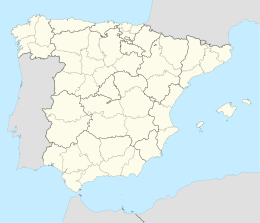
 Location in the autonomous community of the Balearic Islands
Location in the autonomous community of the Balearic Islands